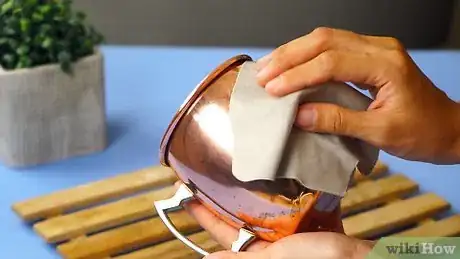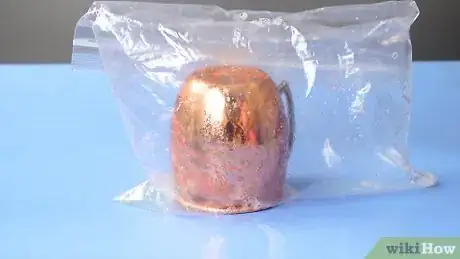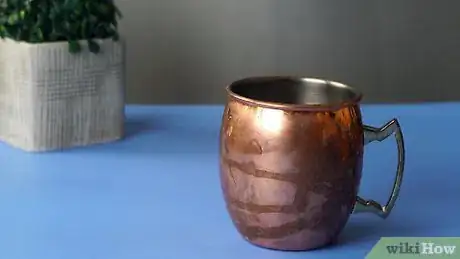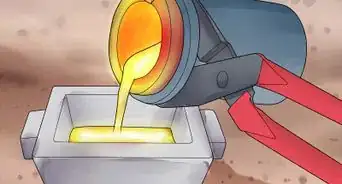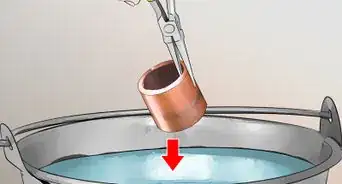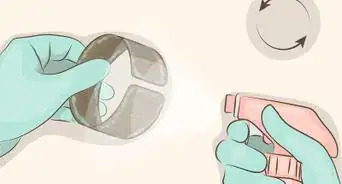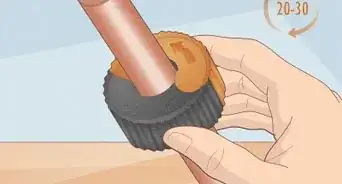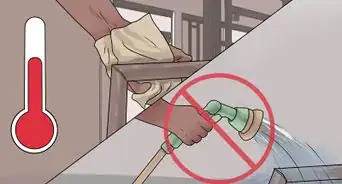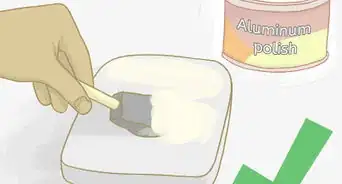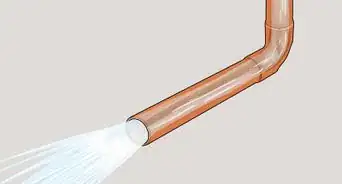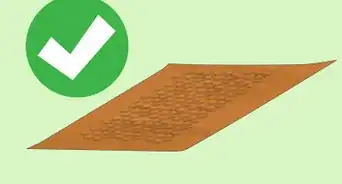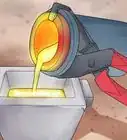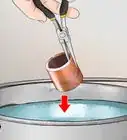wikiHow is a “wiki,” similar to Wikipedia, which means that many of our articles are co-written by multiple authors. To create this article, 14 people, some anonymous, worked to edit and improve it over time.
The wikiHow Video Team also followed the article's instructions and verified that they work.
This article has been viewed 365,816 times.
Learn more...
When copper reacts with the oxygen in the air, copper oxide (CuO) is formed, giving the copper a greenish color which some people desire for its classical look. When allowed to age naturally, copper can take years to develop what's called the verdigris patina, especially in dry climates. If you know how to age copper artificially, however, you can achieve the same effect much more quickly, almost overnight. The process is simple, and you can use common household supplies to do it, rather than harsh or dangerous chemicals.
Steps
Preparing the Project
-
1Wipe the surface completely with a lint-free cloth. For the aging process to be effective, the copper must be free of oils and other surface contaminants, meaning that you'll need to take a little bit of time to clean up the object before you attempt to age it. Be sure to clean the entire surface, including small crevices for the best effect.[1]
-
2Mix the aging compound. To quickly oxidize your copper, the best mixture involves one cup (.24 liter) of plain white vinegar, 3/4 cup (.18 liter) of household ammonia, and 1/4 cup (.19 liter) of table salt. Mix the ingredients into a spray bottle for easy application, and shake it up to mix the ingredients thoroughly.[2]
- For the best effects, non-iodized table salt would be more desirable. Whatever kind of salt you use, try to dissolve it as much as possible to avoid scratching up your copper.
- Some aging compound recipes also like to add a 1/4 cup (.19 liter) of lemon juice to the mixture. If you have lemon juice, use equal parts of all the ingredients listed above.[3]
Advertisement -
3Spray the object with window cleaner. After dusting the object thoroughly, clean it up with some commercial window cleaner, preferably one with an ammonia base. After giving it a light coat, wipe it down with the same cloth, buffing out as much of the dust and grime as possible.[4]
- Spray the copper lightly with the window cleaner again, but do not wipe it off this time. This serves to break the invisible surface tension so that the aging compound makes solid contact with the metal itself.
Aging the Copper
-
1Cover the object with the patina mixture. Once you've cleaned up your copper piece and sprayed it with the window cleaner, apply the aging compound, covering the object completed. Make sure to get into even the smallest spaces, creating an even coat.
- Don't over-do it. It's not necessary to soak the piece, so it's dripping all over the place. Just use enough to wet it in an even coat.
-
2Cover the object. To create humidity, it's usually recommended that you place the copper object into a plastic bag, or tent it under a piece of plastic to create an artificial environment while the aging compound works. Allow the piece to sit undisturbed for about an hour.
- If you live in an area with high humidity, or if you apply the mixture during a rainstorm, you do not need the plastic's artificial environment. In general, it's an advantage to try to age copper at the wettest or most humid point in the year, to give yourself the best natural benefit in the environment.
-
3Reapply the aging compound. Remove the item from the plastic and apply the patina mix again, once more making certain that you have covered the entire metallic surface. Return it to the humidifying bag or tent, and allow it to rest overnight.
-
4Continue reapplying as desired. The amount of coloring you want on your copper piece will be up to you. Remove the piece from the bag each morning and examine it thoroughly, then add more aging compound if necessary and repeat the process if you want to get more color on the piece.
- In general, you probably won't want to age a piece using this method for too long, especially if you live in a humid climate. Remember that the copper will age naturally with time, as well, so you don't have to do too much to get the effect you want on an object you'll have for a long time.
-
5Clean the object with a clean cloth. After you've achieved the age coloring you like, spritz a clean cloth with a small amount of window cleaner and wipe it down to get any of the remnants of the aging compound off, and return the copper to it's place.
Community Q&A
-
QuestionWhy did one side turn pink when the other three sides came out greenish-brown?
 Community AnswerYour problem is probably vinegar in the mixture. Acetic acid (present in vinegar) will "pickle" or slightly etch your copper, removing the patina. If you added more vinegar than necessary, or if the piece sat in a puddle of the mixture, this could cause the fresh pink copper color.
Community AnswerYour problem is probably vinegar in the mixture. Acetic acid (present in vinegar) will "pickle" or slightly etch your copper, removing the patina. If you added more vinegar than necessary, or if the piece sat in a puddle of the mixture, this could cause the fresh pink copper color. -
QuestionHow do I best preserve the patina on oxidized copper?
 Community AnswerOnce the level of oxidation has been achieved, if you don’t want the greenish Statue of Liberty color, you will need to coat the outer layer with a protective coat of varnish or clear paint to stop the oxidation process. The copper will continue to patina until the greenish color is reached and it will then stay that way, you don't need to do anything special to "reserve" the look.
Community AnswerOnce the level of oxidation has been achieved, if you don’t want the greenish Statue of Liberty color, you will need to coat the outer layer with a protective coat of varnish or clear paint to stop the oxidation process. The copper will continue to patina until the greenish color is reached and it will then stay that way, you don't need to do anything special to "reserve" the look. -
QuestionWill spraying varnish on copper age it?
 Community AnswerSpraying varnish or lacquer on it would actually provide a protective coat to the copper that would prevent oxidation (patina).
Community AnswerSpraying varnish or lacquer on it would actually provide a protective coat to the copper that would prevent oxidation (patina).
Warnings
- Use ammonia products only outdoors or in well-ventilated areas, as the fumes can be toxic.⧼thumbs_response⧽
Things You'll Need
- Window cleaner
- Lint-free cloth
- Lemon juice (optional)
- Household ammonia
- Vinegar
- Salt
- Plastic bag
References
About This Article
To age copper, wipe down the surface of the entire piece with a lint-free cloth to remove any oils and dirt. In a spray bottle, mix an aging compound out of vinegar, household ammonia, and table salt. Spray the copper with window cleaner, then coat the item with the aging compound. Place the object into a plastic bag to create humidity. After about an hour, remove the item from the plastic and apply the patina again. Return it to the bag and allow it to rest overnight. When you’ve achieved the color you want, spray the item with window cleaner and wipe it with a dry cloth. For tips on aging a larger item, read on!
